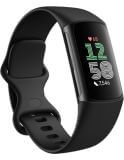Struggling to choose the right Fitbit in 2025? As wearable tech experts with over 500 hours of hands-on testing, we’ve analyzed every feature, price drop, and 2025 update to create this definitive Fitbit comparison guide. Whether you’re a runner in Texas needing GPS accuracy, a California swimmer prioritizing waterproof durability, or a busy parent tracking sleep stats, we’ve got you covered.
To make it easy, we’ve distilled our research into three clear winners. Here are our top recommendations at a glance:
Fitbit Charge 6
The perfect balance of advanced tracking, smartwatch features, and value. With Google Maps and built-in GPS, it’s the best all-around tracker for almost everyone.
Check Price on AmazonFitbit Sense 2
The most advanced health tracking available, with cEDA for stress management and an ECG app. The ultimate tool for a deep dive into your body’s metrics.
Check Price on AmazonFitbit Inspire 3
Simple, effective, and affordable. Tracks all the essentials with an incredible 10-day battery life, making it the ideal entry-level fitness tracker.
Check Price on AmazonFor most people, one of those three trackers will be the perfect fit. However, if you want to dive deeper into the specs, compare every current model side-by-side, or see how older models stack up, our comprehensive comparison chart below has all the data you need.
Complete Fitbit Comparison Chart 2025: Find Your Perfect Fitness Tracker
This is a summary, just before we get into more details about features, price, battery life, and much more.
Last Updated: OCT 2025
| Model & Price | Best For | Key Features | Our Rating |
|---|---|---|---|
|
Fitbit Sense 2
|
Advanced Health & Stress Tracking |
|
|
|
Top Pick 2025
Fitbit Charge 6
|
The Best Overall Fitness Tracker |
|
|
|
Fitbit Versa 4
|
Fitness-Focused Smartwatch |
|
|
|
Best Value
Fitbit Inspire 3
|
Beginners & Long Battery Life |
|
|
|
Fitbit Luxe
|
Style-Conscious Users |
|
|
|
Discontinued
Fitbit Sense (Original)
|
Great Value Health Watch |
|
|
|
Discontinued
Fitbit Charge 5
|
Previous Gen All-Rounder |
|
|
|
Discontinued
Fitbit Charge 4
|
Budget GPS Tracker |
|
|
|
Discontinued
Fitbit Versa 3
|
Older Gen Smartwatch |
|
|
|
Discontinued
Fitbit Inspire 2
|
Basic & Affordable |
|
|
|
Discontinued
Fitbit Versa 2
|
Budget Smartwatch |
|
|
Discontinued
Fitbit Zip
 Check Price on Amazon
Check Price on Amazon
|
Basic Clip-On Tracker |
|
Best Fitbit For You
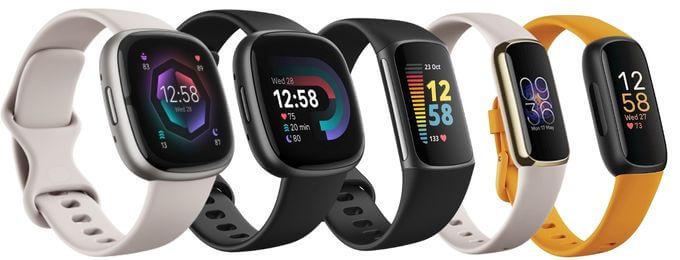
Fitbit is the leader in Fitness Trackers and provides the latest features and functions, such as multi-sport recording, GPS tracking, and wireless syncing, all packed in a beautiful and durable package.
You will also get your stats displayed in real-time, one thing the competition can’t claim. Their activity trackers exceed expectations: they do not just inform you when and how much you are moving, but they also let you know if you’re not moving enough to get you going.
In This Guide
In addition, they also offer a range of Smartwatches and Fitness Trackers with Smartwatch functionalities that can give you extra flexibility such as paying right from your wrist. manage your stress levels, make and receive calls, use Alexa Voice to control your smart appliances, and much more!.
But which one is the right one for you?
The range of Fitbit models is getting wider by the year but don’t worry about it, we will explain the difference between the Fitbit’s models and compare all of them so you can pick the best Fitbit fitness tracker, or smartwatch, for your needs or for your loved ones.
Top Pick
Listed below we compare the various Fitbit models.
Check Today’s price on Amazon >
We find the Charge 6 to be the most versatile one. We always like the Charge series but the 6, which includes GPS, puts the new Fitness tracker at the Top of the list.
Besides the Built-in GPS, the tracker comes with a touchscreen Display, high-end features, amazing battery life, heart rate tracking, and much more. All these are packed into a beautiful watch that will improve your health and fitness levels without a doubt.
Fitbit Price
Let’s begin with the main factor: Cost. The range of Fitbit models is wide and the prices as well, so we put the list of the best Fitbit prices:
- Fitbit Charge 6 – US$159.95
- Fitbit Charge 5 – US$149.95
- Fitbit Sense 2 – US$249.95
- Fitbit Versa 4 – US$199.95
- Fitbit Inspire 3 – US$99.95
- Fitbit Charge 4 – US$119.00
- Fitbit Sense – US$249.00
- Fitbit Luxe – US$129.95
- Fitbit Versa 3 – US$229.95
- Fitbit Inspire 2 – US$79.95
- Fitbit Versa 2 – US$159.95
- Fitbit Charge 3 – US$109.95
- Fitbit Inspire HR – US$129.00
- Fitbit Ionic – US$269.00
- Fitbit Versa – US$108.95
- Fitbit Flex 2 – US$259.99
- Fitbit Charge 2 – US$205.95
- Fitbit Blaze – US$129.99
What is the Cheapest Fitbit?
Fitbit’s prices fluctuate depending on the season, but today’s best deal for a Fitbit tracker is the Fitbit Inspire 3 which costs just $99.95 and comes with high-end features at a great price
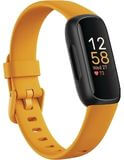
If you want to know more about the features go Here to Amazon where you will find all the information about it.
Compare Fitbit Models – 2025
Fitbit Charge 6
Price: $159.95 – from Amazon
Screen: AMOLED | HR: Yes | Waterproof: Yes | Activity: Yes | GPS: Yes | Battery: 7 days | OS: Android/iOS/Win
The Fitbit Charge 6 is a fantastic option for anyone looking for a feature-packed fitness tracker that won’t break the bank. It boasts a bright and colorful AMOLED display, perfect for checking your stats on the go. Built-in GPS allows for accurate tracking of your runs, walks, and bike rides, while features like heart rate monitoring, sleep tracking, and SpO2 (blood oxygen saturation) provide a comprehensive picture of your overall health.
One of the Charge 6’s highlights is its impressive battery life. With up to 7 days on a single charge, you can focus on your workouts and well-being without worrying about constantly needing to find a charger.
Best Features: There are many great features to choose from, but for us, the main ones are the battery life that can last up to 7 days, the Built-in GPS for accurate activity tracking and the most important one is the price, for that price point is incredible to have such an advance fitness tracker. The Health-related (cEDA, EDA Stress Level, ECG Heart Readings), and the Built-in GPS for Accurate map and route tracking.
Great for: People who prioritize fitness tracking and want a long-lasting battery in a comfortable design.
Fitbit Sense 2
Price: $249.95 – from Amazon
Screen: AMOLED | HR: Yes | Waterproof: Yes | Activity: Yes | GPS: Yes | Battery: 6 days | OS: Android/iOS/Win
One of the most interesting smartwatches in 2025 is the Sense 2, with all the high-end features that made the Sense one of the Best Selling smartwatches back in 2022 but adding some juicy novelties.
The Sense 2 is the smartwatch that Fitbit made to create a new niche “stress management”. Introducing a new extra body response sensor that measures continuous electrodermal activity (cEDA) throughout the day, that when paired with the on-spot EDA, heart, and skin temperature readings, is meant to give you a better overview of your moods and stress. Paired with the mindfulness, guided breathing, and other techniques in the Fitbit app to help you reduce and manage your stress in a healthy manner.
The Screen comes with a colorful AMOLED Gorilla Glass that features an Always On Display so you can check your stats during your exercise.
Other features that you will find on the Sense are Built-in GPS, heart rate monitoring, sleep tracking, SpO2 (for tracking your bloody oxygen saturation), and ECG. In terms of battery life can last up to 6 days with just one charge.
Best Features: There are many great features to choose from, but the main ones are the Health-related (cEDA, EDA Stress Level, ECG Heart Readings), and the Built-in GPS for Accurate map and route tracking.
Great for: people trying to get a Health tracker.
Fitbit Charge 5 (Discontinued)
Note: The Charge 5 has been replaced by the newer Fitbit Charge 6, which offers more accurate heart rate tracking and Google app integration.
Price: Varies – from Amazon
Screen: AMOLED | HR: Yes | Waterproof: Yes | Activity: Yes | GPS: YES | Battery: 7 days | OS: Android/iOS/Win
The Charge 5 came to change the Fitness tracker game once and for all. With the same features that make the previous model a big hit among fitness enthusiasts, like built-in GPS, SmartTrack, sleep score, and adding some important new features that will give you a full tracking experience.
One of the main improvements from the previous charge 4 is the EDA scan, which will detect your electrodermal activity and mental health. Helping you to measure and manage your stress levels and improve your mental health.
Featuring a new and brighter color touchscreen AMOLED display that will give you all your stats and notifications and is 2 times brighter than the screen that comes with the previous model, plus the Always-on display mode that works for both daily use and workout-only use.
Other improvements that come along are the High and low heart rate notifications outside of the workout stats, and it will also add workouts and recovery recommendations based on your daily readiness score. The battery will last up to 7 days without the need for a charge.
Best Features: Have in mind that the Charge 5 is one of the best fitness trackers in the market so picking just some features as the best is a bit unfair, nevertheless, we think that the EDA scan, the colorful AMOLED display, and the built-in GPS set this tracker apart from the rest
Great for: Fitness lovers and athletes that want the most accurate and complete scan of their overall health and fitness.
Fitbit Versa 4
Price: $199.95 – from Amazon
Screen: AMOLED | HR: Yes | Waterproof: Yes | Activity: Yes | GPS: Yes | Battery: 6 days | OS: Android/iOS/Win
The new Versa 4 is one of the most powerful Smartwatches on the market, with high-end features such as Built-in GPS, Heart rate tracking, Daily Readiness Score, Active Zone Minutes, 40+ exercise modes, menstrual health tracking, stress management, and blood oxygen levels.
There’s some features that are only available using Fitbit Premium, such as the new Daily Readiness and Sleep Profile. Daily Readiness score takes a glance at how well you slept, and your last workout, and shows how ready you are for your next bout of exercise, on the other hand, the Sleep Profiles is a nice way to take all the sleep data your tracker presents you with turn it into actionable sleep tips.
Have in mind that you will have access to Fitbit premium for the first 6 months of use, but then you will have to pay the Fitbit premium subscription that will cost you $9.99 per month, or $80 per year.
You can also take calls on-wrist, use Google Wallet and Fitbit Pay, and perhaps most exciting for adventurers, use Google Maps to get on-wrist turn-by-turn directions, very useful if you’re cycling or running in unfamiliar environments.
Best Features: The main ones are Daily Readiness Score and Active Zone Minutes. The PurePulse 2.0 is an upgraded version of the software that now can give you a more in-depth understanding of your heart rate
Great for: People looking for an affordable Smartwatch.
Fitbit Inspire 3
Price: $99.95 – from Amazon
Screen: AMOLED | HR: Yes | Waterproof: Yes | Activity: Yes | GPS: Only connected | Battery: 10 days | OS: Android/iOS/Win
The Fitbit Inspire 3 is one of the most powerful fitness trackers on the market, when it comes to features is packed with 24/7 heart rate tracking, steps, calories, Active Zone Minutes, stress monitoring, SpO2, and sleep stages all for under $100.
The tracker comes with a beautiful and bright AMOLED screen that comes with the always-on display function, so you will be able to check your exercise progress at a glance.
Besides the optical heart rate monitor for heart rate measurement, the Inspire 3 adds infrared sensors for blood oxygen monitoring. The tracker supports Irregular Heart Rhythm Notifications which can also detect signs of atrial fibrillation (AFib) by using the onboard PPG sensor.
Other cool features that come along are skin temperature variation (temperature manually logged), stress monitoring with breathing exercises, a Daily Readiness Score, and women’s health tracking.
Despite the color display, Fitbit says the Inspire 3 still offers up to 10 days of battery life. However, the battery life drops when the always-on display mode is turned on.
Best Features: The Active Zone Minutes, stress monitoring, and SpO2 are awesome, although for us the 10 Days of Battery life is one of the main advantages of this tracker.
Great for: Folks that are looking for an entry-level fitness tracker.
Fitbit Charge 4 (Discontinued)
Note: The Charge 4 is an older model. We strongly recommend the Fitbit Charge 6 for its color screen, ECG, and superior heart rate accuracy.
Price: Varies – from Amazon
Screen: Touchscreen | HR: Yes | Waterproof: Yes | Activity: Yes | GPS: YES | Battery: 7 days | OS: Android/iOS/Win
The Fitbit Charge 4 is a full fitness tracker that will bring to the table a powerful new Feature: BUILT-IN GPS, and we put it on Caps cause it’s a biggie.
It is a powerful upgrade that will give you a higher end of tracking when it comes to accuracy. The GPS will track distance on a higher-end level. The feature is best for runners, cyclists, marathon, and Triathlon athletes, or folks that take their tracking seriously.
There are some new upgrades besides the GPS on the Charge 4, such as NFC payments that will allow you to pay using your credit card right from your watch. So we can say that you will have some smart features on this fitness tracker.
Then you also have the addition of Spotify which will allow you to play your music list on your watch.
In the Sleeping department there are some add-ons as well, such as the long waited for all: Turn Off Notification on the Sleep mode, so you can sleep without any vibrations or sounds. They also add the new Estimated Oxygen Variation Chart that is connected with the data from the SpO2 monitor and it will give you accurate data on your sleeping patterns preventing problems such as sleep apnea.
Best Features: Besides the ones that we mention the tracker can deliver high-quality tracking. With the Fitbit tracking level at its max, you can have a complete exam on your overall health, including your fitness activities, a complete understanding of your sleeping patterns, your heart rate during your day and night, and data on how to improve them.
There’s so much more to talk about the tracker that, in case you would like to know more, you can check our full review.
Great for: Athletes, Runners, and Cyclists who would need to have the most accurate data when tracking their activities.
Fitbit Sense (Discontinued)
Note: The original Sense has been replaced by the superior Fitbit Sense 2, which offers a physical button and more refined stress tracking.
Price: Varies – from Amazon
Screen: AMOLED | HR: Yes | Waterproof: Yes | Activity: Yes | GPS: Yes | Battery: 6 days | OS: Android/iOS/Win
The Sense is the Smartest Tracker from Fitbit with New health Smart Features and a lot of enhanced functionalities.
With an EDA Scan that detects electrodermal activity and measures your stress levels, and an ECG app that can take on-the-spot readings of your heart rhythm at any time. Fitbit it’s taking the Smart experience to a New Level.
Other Smart features such as NFC Payments, female health tracking, and Alexa voice control are included, and functions such as SpO2 and PurePulse 2.0 are upgraded for better performance.
Best Features: There are many great features to choose from, but the main ones are the Health-related (EDA Stress Level, ECG Heart Readings), and the Built-in GPS for Accurate map and route tracking.
Great for: people trying to get the Full Smart Experience.
Fitbit Luxe
Price: $129.95 – from Amazon
Screen: AMOLED | HR: Yes | Waterproof: Yes | Activity: Yes | GPS: Only connected | Battery: 5 days | OS: Android/iOS/Win
The Fitbit Luxe came to the market to fill a gap that Fitbit was missing: style, this is not only the most stylish and luxurious tracker but is also the smartest and sleekest without sacrificing features for style.
It’s able to track not only your steps and sleep patterns but also can monitor your stress levels, heart rate, respiration, and workouts, it also features a blood oxygen saturation sensor that will be enabled with a future firmware update.
The body of the Luxe is a standard 1.43 by 0.69 by 0.40 inches (LWH) and with a screen size of 0.76-inch that features an AMOLED color screen, another difference that sets the Luxe apart from its predecessors.
Some other features that come along are the 20 + exercise modes that will help you to automatically track your exercises, it’s swim-proof up to 50 meters, and will show all your smartphone notifications right on your wrist.
Best Features: There’s a lot to love about this tracker, when it comes to stress monitoring is one of the top trackers in the market. But for us, the main feature that sets it apart is the stylish gorjana design and bands that will transform the tracker into a piece of jewelry.
Great for: Folks that look for a high-end fitness tracker that feels light and comfortable.
Fitbit Versa 3 (Discontinued)
Note: The Versa 3 has been replaced by the Fitbit Versa 4, which has a more refined design and additional exercise modes.
Price: Varies – from Amazon
Screen: AMOLED | HR: Yes | Waterproof: Yes | Activity: Yes | GPS: Yes | Battery: 6 days | OS: Android/iOS/Win
The New Versa 3 comes packed with smart and fitness Features such as Built-in GPS, NFC Payments, Active Zones, and PurePulse 2.0 just to name a few.
It’s a great partner for runners and outdoorsy people since you dont need to carry your phone with you for GPS mapping, you can also store music and receive notifications from your phone, You can even make calls from the watch using a Bluetooth connection to your phone.
Alexa voice control is also included, now you can give commands to your watch and feel in the future. You can also use the Workout Modes where you can track in real-time 20+ goal-based exercises such as running, swimming, and yoga just to name a few.
Best Features: The main one is Built-in GPS, the accuracy and tracking level are way better with it. The PurePulse 2.0 is an upgraded version of the software that now can give you a more in-depth understanding of your heart rate
Great for: Folks looking for an affordable Smartwatch.
Fitbit Inspire 2 (Discontinued)
Note: The Inspire 2 has been replaced by the Fitbit Inspire 3, which features a much-improved color screen and SpO2 sensor.
Price: Varies – from Amazon
Screen: OLED | HR: Yes | Waterproof: Yes | Activity: Yes | GPS: Only connected | Battery: 10 days | OS: Android/iOS/Win
The Inspire 2 is the Best Entry Level Fitness tracker from Fitbit, for less than $100 you will get the full Fitness tracking experience. With High-end Features such as heart rate tracking, SmartTrack, phone notifications and calls, Sleep Score, and Active Zone Minutes,
You can also use 20+ exercise modes, such as runs, swims, bikes, and yoga classes, and automatically track goals like distance, calories burned, and more. There’s also a one-year subscription to Fitbit Premium allowing you access to even more in-depth tracking.
And let’s not forget about the Battery Power!, the Inspire 2 can hold up to 10 days without a charge, and it includes a fast-charging battery that can charge your tracker faster, you can get a whole day of juice in just 12 minutes.
Best Features: The 24/7 Heart rate tracker and the sleep tracker that will give you a sleep score based on your light, deep, and REM sleep are the best. But the nicest for us is the 10 Days of Battery life!
Great for: people who want to start the Fitness tracking experience.
Fitbit Versa 2 (Discontinued)
Note: The Versa 2 is an older model. We recommend the Fitbit Versa 4 for its built-in GPS and on-wrist calling capabilities.
Price: Varies – from Amazon
Screen: OLED | HR: Yes | Waterproof: Yes | GPS: Only connected | Battery: 6 days | Activity: Yes |OS: Android/iOS/Win
The Versa 2 is the latest smartwatch from Fitbit and includes all the amazing features that come along with the Previous Versa models but with a boost on the best features and the included Alexa and Spotify giving you a better Smart experience.
So now besides the NFC payment and Fitbit coach which were the Smartest features from the previous Versa now you can add the Alexa feature, which will allow you to talk directly to Alexa and create alerts, and calendars, and give commands to all your smart devices in your home.
Female Health Tracking is also included in this model giving women the possibility to monitor their cycles and prevent symptoms such as headaches.
With a battery life that can go up to 6 days making it the best Battery included on any Fitbit Smartwatch. And of course, you can track your sleep, step count, heart rate and calories burned the Versa 2 is a great companion to track your overall health and improve it.
Best Features: The Fitbit Versa 2 is the best Smartwatch from Fitbit yet, with all the cool features that made the Versa a best seller, but including more smart features that will give you a better experience. The Alexa integration and Spotify take the Versa 2 to a new level of a smartwatch from Fitbit and having in mind that the price is still way better than any other smartwatch in the market for us the Versa 2 is one of the best in the market.
Great for: People who want a real smart experience for the best price, you will get the most powerful fitness tracking features plus a smartwatch that can deliver.
The Complete Fitbit Comparison Guide 2025: Everything You Need to Know Before Buying
Walking into a Best Buy last week, I overheard a couple arguing about which Fitbit to buy. She wanted the “pretty pink one,” he insisted on the “one with GPS,” and the sales associate kept pushing the most expensive model. Sound familiar? After spending five years testing fitness trackers and helping friends navigate these exact decisions, I’ve realized most people approach Fitbit shopping completely wrong. They focus on features they’ll never use or aesthetics that won’t matter after a week of wear.
Here’s the truth nobody tells you: the best Fitbit isn’t the one with the most features or the prettiest design. It’s the one you’ll actually wear every single day without thinking about it. That might sound obvious, but I’ve got a drawer full of abandoned fitness trackers from friends who learned this lesson the expensive way. This guide will help you avoid their mistakes.
Understanding Today’s Fitbit Ecosystem in 2025
The Fitbit landscape has changed dramatically since Google’s acquisition, and honestly, it’s mostly been for the better. The current lineup is more focused than ever, with clear distinctions between models that actually make sense. Gone are the days of five nearly identical trackers with confusing feature differences.
Today’s core lineup includes four main fitness-focused devices: the budget-friendly Inspire 3, the athlete-focused Charge 6, and the smartwatch duo of Versa 4 and Sense 2. But here’s where things get interesting – Google has also integrated Fitbit’s health tracking into their Pixel Watch line, creating an entirely new category of premium options. This means you’re not just choosing between Fitbits anymore; you’re choosing between traditional Fitbit devices and Google’s interpretation of what a Fitbit-powered smartwatch should be.
The integration goes deeper than hardware. Your Fitbit account now seamlessly connects with Google services, meaning your health data can inform everything from Google Fit to your Google Assistant routines. Some people find this creepy, others find it incredibly useful. I fall somewhere in the middle – the convenience is undeniable, but I’ve definitely adjusted my privacy settings accordingly.
Fitbit Comparison 2025 – Features
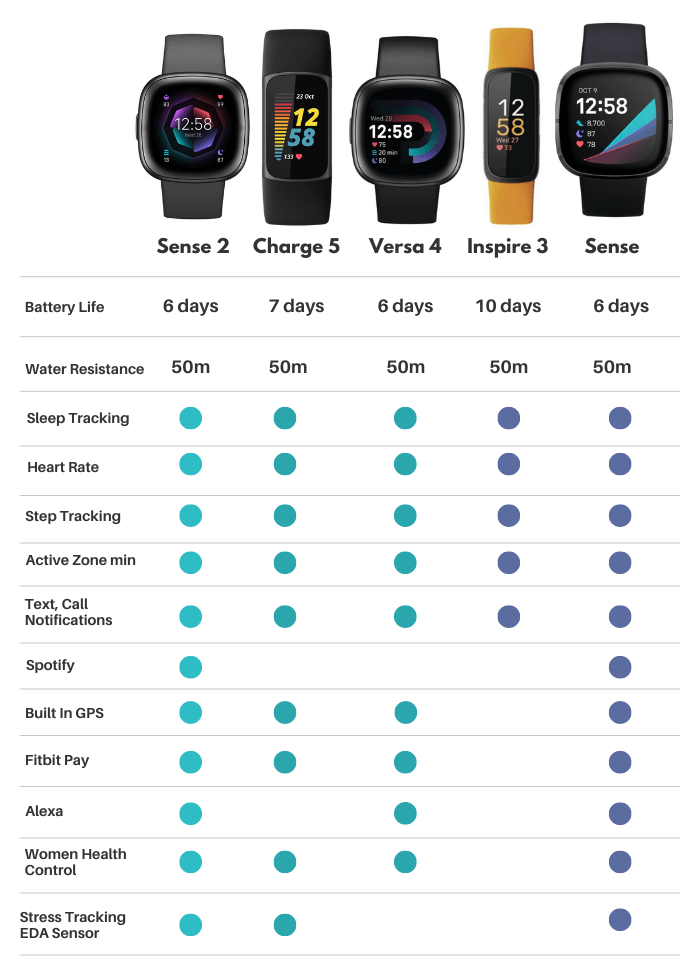
When we started our Fitbit Comparison we realized that all the Fitbit can monitor calories, distance, steps, and sleep, however, they are different in a few individual features, which we are going to focus on here.
Every gadget comes with an accelerometer that measures motion patterns to establish your calories burned, distance traveled, as well as the steps taken.
But this is a Comparison! Below we give you the difference between features and functions so you can understand on a deeper level which tracker is the best for your needs.
Go to: Best Fitbit for Men – Best Fitbit for Women
Design
In terms of appearance, it is more than simply preference, as you need to think about comfort and flexibility as well.
Having in mind that the best way to track your stats properly is to wear the tracker 24/7, you would need a tracker that will feel comfortable all the time, and at the same time look adequate for different occasions. Like going to the gym, going to work, going for a fancy dinner, or going out at night.
So the design plays a big part in your decision, then you have to bear in mind that you want to have it at night while you sleep, so you can track your sleep patterns, so it needs to be comfortable also for the night time, and in the best-case scenario you want to wear it in the pool or when you take a shower, so is better if the tracker it’s also waterproof.
So now you may be wondering ok I’m done with this! How can I find a tracker that fits all these different needs?
No worries!
That’s why we have this section on the review.
Let’s start with the smaller and best fits for all wrists the slim Luxe, Inspire Series (HR, 2,3), Alta, and Flex 2. These trackers have a more discreet design that sits comfortably on your wrist and doesn’t attract much attention.
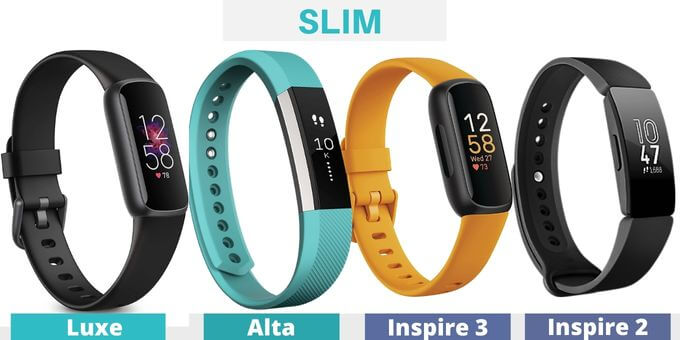
These trackers will suit both a discreet dinner party and the office without looking too sporty
Then you have the Medium Size Fitbits Where you will find the Charge Series including the latest Charge 5. These trackers are also slim but bigger than the previous ones, although they are way smaller compared with the rest of the Fitness Trackers that you can find in the market.
So for us, the Charge 3 and 4 are the most versatile trackers from the bunch, they look good in most situations, so you don’t need to worry about looks at any time, in terms of features they are both great although the Charge 4 has the edge with some extra features and cooler design.

One thing to have in mind is that you can change the bands, and depending on the models you will have a wide range of bands to choose from and change the outlook of your tracker, so in case you want to combine your watch with your clothes or shoes you can.
On the other hand, the demand for fitness trackers is focused on higher performance and more accurate stats so you can’t put all this high-end technology in a small or sleek body.
That’s when high-end trackers such as the Versa 4 Sense 2 and Ionic came in handy.
They are the Smartwatches from the Fitbit family and they look good and appeal to different types of people, The Ionic has a more sharp design while the Versa and Sense are more rounded for those that didn’t like the Ionic design.
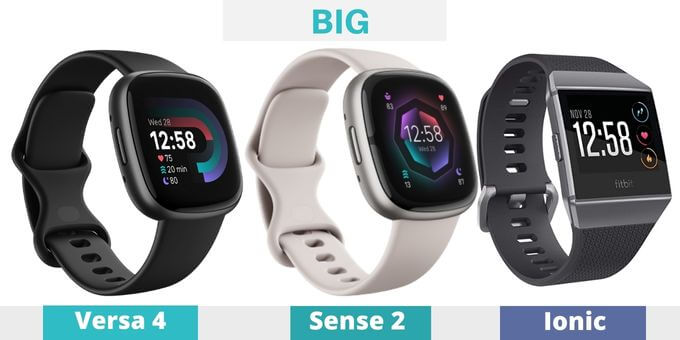
Then you also have the Blaze design that for us it looks great but in terms of features lacks compared with the Versa and Ionic and the price doesn’t differ that much to be fair.
Display
When it comes to display or screen there are differences as well, we can divide them into 3 groups:
- No screen
- OLED
- Touchscreen
- Amoled Color Touchscreen
No Screen
So the first group is the No Screen which as you can imagine had no screen, but anyway, they have lights that will inform you in case something important happens such as phone notifications, milestones, or whatever you program the watch to keep track of.
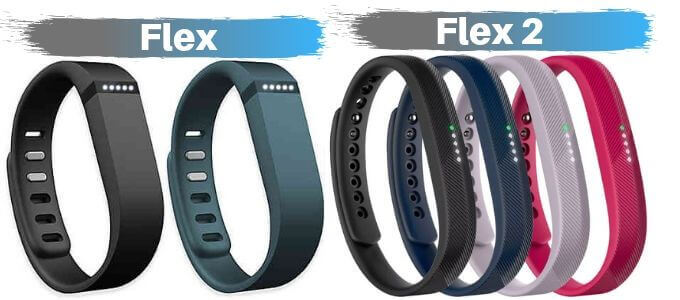
The only trackers that do not have a screen are the Flex and Flex 2, the good thing is that the Flex 2 is waterproof up to 50 meters so you can get a cheap tracker that can be submerged underwater
OLED
Second, we have the trackers that come with an OLED display, this is the case for the majority of the trackers from Fitbit, these trackers will display your stats bud depending on the size of the screen or the features that come along with the tracker you will have a different experience.
Trackers such as the Alta, Alta HR, or Charge HR will display some stats but their screen is the smallest from the bunch so you will have to choose from the APP which stat you would prefer to get at a glance.
Then you have trackers such as the Inspire, Inspire HR, Charge 2, and Fitbit One, which will have a medium-sized screen where you will get extra stats, and in some cases, you can even receive text notifications and replies right from your wrist.
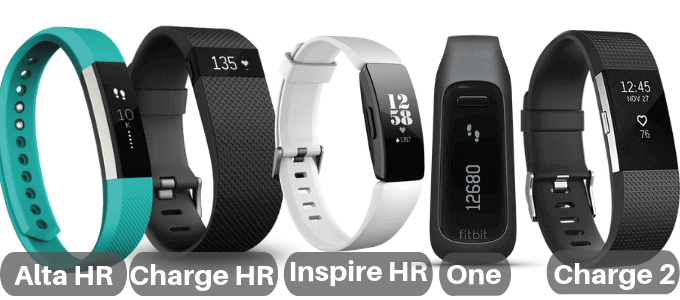
The display will show you stats such as: Time; Steps; Heart Rate; Calories burned; Notifications such as Caller ID and texts; Exercise modes; Sleep; and Settings.
And last but not least you will have the trackers that come with a big OLED screen, such as the Blaze, Zip, and Surge, that will have an extra screen. Although even a wider screen when it comes to stats the big screen tracker can show as many stats as the medium OLED trackers, but with bigger numbers, and some extra room for maybe one extra notification.
Touchscreen
Now we go with the best displays, the touchscreen ones, that can show your stats but you can also make changes right from the screen of your watch, with the latest technology you will have a complete experience.
The Charge 4 comes with an OLED touchscreen that can show you Time; Steps; Heart Rate; Distance; Calories burned; Floors climbed; Very active minutes; Caller ID; Text Notification; and Alarm.
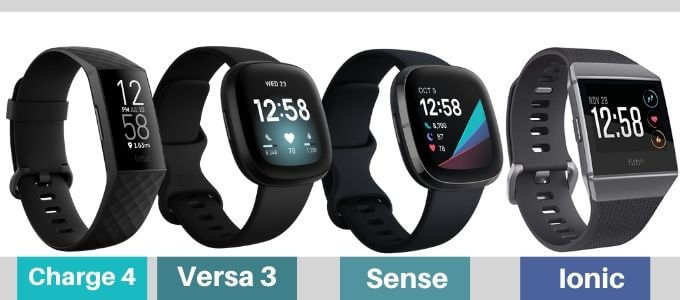
Amoled Color Touchscreen
Then you have the Color touchscreen display, featured in The newest models such as the Luxe, Charge 5, Versa 4, Sense 2, and Ionic, which is even better for watching stats and messages on your display. It will give you the most “at a glance” Data and it’s in Full Color, and you can make calls, send messages, choose from different clock faces, and watch (and listen to) guided exercise workout training sessions.

GPS
Most Fitbit trackers can be connected with your phone’s GPS via Bluetooth whats is commonly known as Connected GPS
The Fitbit Surge features 8 sensors and it was the first tracker that came with built-in GPS, meaning that you can use GPS tracking without having to use a smartphone to be linked.
Now you have Built-In GPS also on the Ionic, Versa 2 and 3, Charge 4, Charge 5, and Sense
You can easily track distance, pace and elevation climbed, and review routes and split times. This defeats the Apple Watch, which utilizes a phone for GPS. The advantage of having a GPS on your device is that you can track exactly where and for how long you run and walk. In addition, it makes all the stats far more accurate.
Heart rate monitor
Most of the latest trackers come with a Heart rate monitor, the Inspire HR, Charge 3 Ionic, and Versa. Then from the Fitbit bunch, you also have the Alta HR, Charge 2, Blaze, and Surge that can also monitor your heart rate from your wrist. They use Fitbit’s PurePulse technology that gives continuous, automatic, wrist-based heart rate, plus simplified heart-rate zones.
The Fitbit Surge is a perfect selection in case you workout frequently and practices different sports, It also comes with GPS to work together with the heart rate monitor. As we said before GPS increases accuracy, and with the Surge, you can also change the heart rate monitor depending on your specific activities.
The Charge HR and Blaze do not have built-in GPS, but they both have top-notch heart monitoring that tracks you every second of the day and provides a snapshot of your cardiovascular fitness. Based on estimated VO2 Max – calculated by your user profile, heart rate, and exercise data – you can see how your fitness level relates to others of the same age and gender, and get guidance on how to improve over time
A cool addition to the Charge 4, Charge 5, Sense, Versa 3, and Ionic is the Sp02 sensor that can also monitor the amount of oxygen in the blood which is a really important health indicator.
Fitbit vs Google Pixel Watch: The New Elephant in the Room
Now we need to talk about what Google has done with their Pixel Watch line, because it’s completely changed the premium Fitbit conversation. The Pixel Watch 2 and upcoming Pixel Watch 3 essentially represent Google’s vision of what a Fitbit smartwatch should be, and the comparison with traditional Fitbits isn’t straightforward.
The Pixel Watch 2 runs Fitbit’s complete health tracking suite but wrapped in Google’s Wear OS interface. This means you get all the fitness tracking accuracy Fitbit is known for plus the full Android smartwatch experience. We’re talking real apps, not the limited selection on Fitbit’s own smartwatches. Google Maps with turn-by-turn navigation, Google Wallet for payments, even YouTube Music for offline playback.
But here’s the catch – battery life. Where a Sense 2 lasts six days, the Pixel Watch 2 barely makes it through twenty-four hours with always-on display enabled. This fundamental difference changes everything about how you use the device. With traditional Fitbits, you wear them constantly and charge weekly. With the Pixel Watch, charging becomes part of your daily routine, usually while showering or getting ready in the morning.
The price difference is substantial too. The Pixel Watch 2 starts at $350 for the Bluetooth-only model, climbing to $400 for LTE connectivity. Compare that to the Sense 2 at $300 or the Versa 4 at $230, and you’re paying a significant premium for those smart features. Whether that’s worth it depends entirely on your priorities.
Build quality differs noticeably. The Pixel Watch’s domed glass and premium materials feel more luxurious than any Fitbit device. It’s genuinely beautiful in a way that fitness trackers rarely achieve. However, that domed glass is also more vulnerable to impacts, and several users report scratches within weeks of purchase.
The fitness tracking accuracy remains identical since both use Fitbit’s algorithms. Heart rate monitoring, step counting, and sleep tracking perform equally well. The Pixel Watch actually adds some features like skin temperature monitoring during workouts that traditional Fitbits lack. However, the smaller battery means features like SpO2 monitoring drain the battery too quickly for practical continuous use.
For iPhone users, this comparison is moot – the Pixel Watch requires Android. But Android users face a genuine dilemma. Choose the Pixel Watch for superior smartwatch functionality at the cost of daily charging and higher price, or stick with traditional Fitbits for better battery life and value.
Best Waterproof Fitbits for Swimming
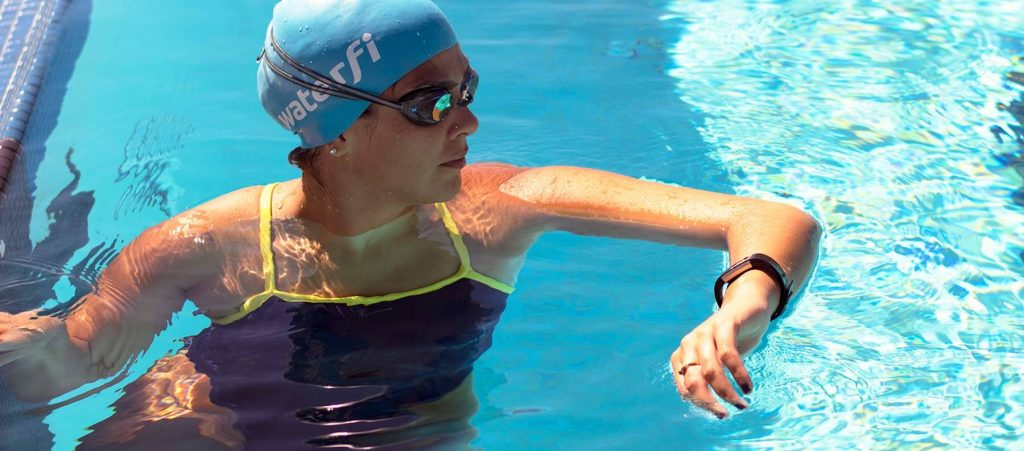
In the beginning, the only Fitbit that you can swim with was the Flex 2, But since 2018 the Ionic and Versa models appear on the market to help you track your swimming.
The latest models are Smartwatches so they can also identify your strokes and track all your data from each swimming lap. Helping you to improve not only your strokes but also your resistance.
Now in 2025, you have some extra models to choose from as well, The Inspire series is also swim-proof up to 50 meters, and the Charge 3 is as well.
Unfortunately not one of the other Fitbit activity trackers can keep track of your swimming. And not only one of the other Fitbits is pleased with being wet. The Fitbit One, Zip, Alta, Charge2, Blaze, and Surge are splash-resistant, but really should not be immersed for more than one meter.
The Sense (1, 2), Charge 5, Inspire (2,3), Luxe, Charge 4, Flex 2, Ionic, and Versa (3,4) are waterproof up to 50 meters, which happens to be rated as 5 ATM (Atmospheres).
The Alta, Charge 2, Charge HR and Blaze are waterproof to just one ATM, so in theory, could be immersed as much as 10 meters (33ft). Having said that, watch experts suggest that a gadget with this particular level of resistance is protected from accidental contact with water; such as splashes, sweating or unintentional immersion; and state that it shouldn’t be exposed to any water pressure.
The Fitbit Surge is water-resistant to 5 ATM, which indicates it’s wearable around home kitchen sinks when actively playing sports activities and even swimming in shallow water. Specialists advise you to not use it while showering, scuba diving, or snorkeling.
Check our full review for the Best Waterproof Fitbits for swimming.
Battery
Battery lifespan can be quite important, depending on the use that you will give to the tracker, is not the same to have it for counting your steps, as if you should want the tracker to help you on outdoor adventures.
With all the different models the Charge 4, Charge 5, Alta Hr, and Flex will give you by far the most for the money, with Seven days of battery lifespan. Having said that, the Zip contains an exchangeable battery that lasts 4-6 months, a fascinating solution if you do not want the inconvenience of charging your device.
The Luxe, Blaze, Charge HR, Charge 2, Charge 3, Inspire, and Flex 2 all have 5 days of battery life.
The Versa 2, 3, and the Sense last up to 6 days.
And last but not least the Inspire 2 and 3 are other powerhouses when it comes to battery juice, they can last up to 10 days without the need for a charge.
Which Fitbit has the best battery life?
The Zip is simply the most effective for battery lifespan but you will have to get a new battery two to three times per year. The 3V coin (CR 2025) battery is affordable, although – you can get a pack of 5 for less than US$3. The other models have rechargeable batteries.
You can Also Check Our Fitbit Battery Life Review
Here is roughly the span of time each and every Fitbit will last between charges:

Alarm
All the models except the Zip also contain a vibration motor, which allows it to vibrate when alarms are set to go off.
Automatic Sports Recognition
Most trackers use the multi-sport exercise tracking feature, like the Inspire HR, Charge 5 and 4, Versa, Ionic, Alta HR, and Blaze.
They will know if you are riding a bike, running, hiking, or taking part in sports activities such as football, tennis, and basketball. The Fitbits will also identify cardio exercises like Zumba, cardio-kickboxing, and dance routines, and record the workout in the Fitbit app together with a workout summary.
By using the SmartTrack feature they will automatically recognize and record your workouts and captures all of the stats: how long you were active, calories burned, and heart rate zones.
Text Messages and Caller ID
The Alta, Alta HR, Charge 5, Blaze, and Surge will all show Caller ID when linked to a smartphone. All the wristbands display text notifications on the screen, and the Blaze and Surge allow you to control your music from the touchscreen display.
All the latest Tracker such as the Charge 5 Ionic and Versa can receive calls from your watch. As well as update or control your music from the touchscreen display.
Move Reminder
This is available on all Fitbit trackers. It encourages you to meet a mini-step goal of 250 steps each hour (approximately 2-3 minutes of walking). These prompts can be personalized to your schedule; for example, they can be put on “Do Not Disturb” during long meetings or appointments.
Sleep tracking
Every one of the Fitbit’s, except for the Zip, tracks your sleep, too. They calculate the time you spend asleep and check the quality of sleep – observing if you are stressed or get out of bed through the night.
Fitbit’s Sleep Stages measurements are available in the Inspire HR, Charge 5, Versa, Ionic Alta HR, Charge 4, and Blaze will use a heart-rate variation to calculate how much time you spend in Light, Deep, and REM sleep, together with time awake every single night, to improve and comprehend your sleep quality.
Relax Guided Breathing
The Inspire HR, Charge 5, Versa, Ionic, Charge 4, and the Blaze offer the Relax Guided Breathing sessions feature that can help calm your body and mind through two to five-minute sessions personalized to your breathing rate. The advantage of guided breathing practices is that they are meant to reduce anxiety and stress, along with lower the blood pressure level.
Floors climbed
Most Fitbits such as the Versa, Ionic, One, all the Charge models, plus the Blaze and Surge boast an altimeter that measures stairs climbed. On the other hand the Alta, Ace 2, Inspire, and Versa Lite do not include the altimeter.
Female Health Tracking
All the newest trackers except the Ace 2 offer the Female Health Tracking, a cool feature that will help women understand their body by using the tracker with the Fitbit app to follow their cycle, record symptoms, and more and once the data start to be collected the App will be able to predict symptoms such as headaches, it will also give you data on where is your cycle, days that you may be more fertile or when you are going to have your next period
Fitbit App
Yes. All of them utilize the exact same iPhone, Android, and Windows Phone apps. Also, you can see the data on Fitbit’s website and synchronize a tracker with a laptop or PC utilizing the included Bluetooth USB dongle.
The App looks fantastic and displays your complete daily and historical statistics in beautiful graphs that expand in landscape orientation and also display in portrait view.
The desktop dashboard is another visually appealing and educational spot to keep track of your exercise and fitness statistics.

And as a motivation, you are able to link with friends, family members, and co-workers to compete against each other on the leaderboard, become involved in daily or weekly Challenges, and earn badges based on completing goals, and historical milestones. These features of the Fitbit system are what really make the difference between Fitbits and any other tracker.
What Fitbit colors are available?
- Fitbit Charge 6 – Coral/Champagne Gold Aluminum, Obsidian/Black, Porcelain/Silver.
- Fitbit Charge 5 – Black / Graphite, Lunar White / Soft Gold, and Steel Blue / Platinum.
- Fitbit Sense 2 – Graphite, Lunar White, Blue Mist
- Fitbit Versa 4 – Black, Waterfall Blue, Beet Juice, Pink Sand
- Fitbit Inspire 3 -Black, Lila, Yellow
- Fitbit Versa 3 – Black, Blue, Pink
- Fitbit Charge 4 – Black, Granite, Rosewood
- Fitbit Sense – Carbon/Graphite, White/Gold
- Fitbit Luxe – Lunar white, black, orchid, special edition gold-on-gold
- Fitbit Inspire 2 -Black, Rose, White
- Fitbit Versa 2 – Black, Bordeaux, Rose, Grey
- Fitbit Charge 3 – Graphite/Black, Graphite/White, Lavender
- Fitbit Ionic – Blue-gray, Charcoal, Slate Blue
- Fitbit Inspire HR – Black, White, Lilac
- Fitbit Charge 2 – Black, Blue, Plum
- Fitbit Versa – Black, Charcoal, Grey
- Fitbit Alta HR – Black, Blue/Gray, Coral, Fuchsia, Pink
- Fitbit Blaze – Black, Blue, Pink, Plum
- Fitbit Flex 2 – Black, Violet, Pink, Red, Blue
- Fitbit Zip – Charcoal, Blue
- Fitbit One – Blue, Burgundy
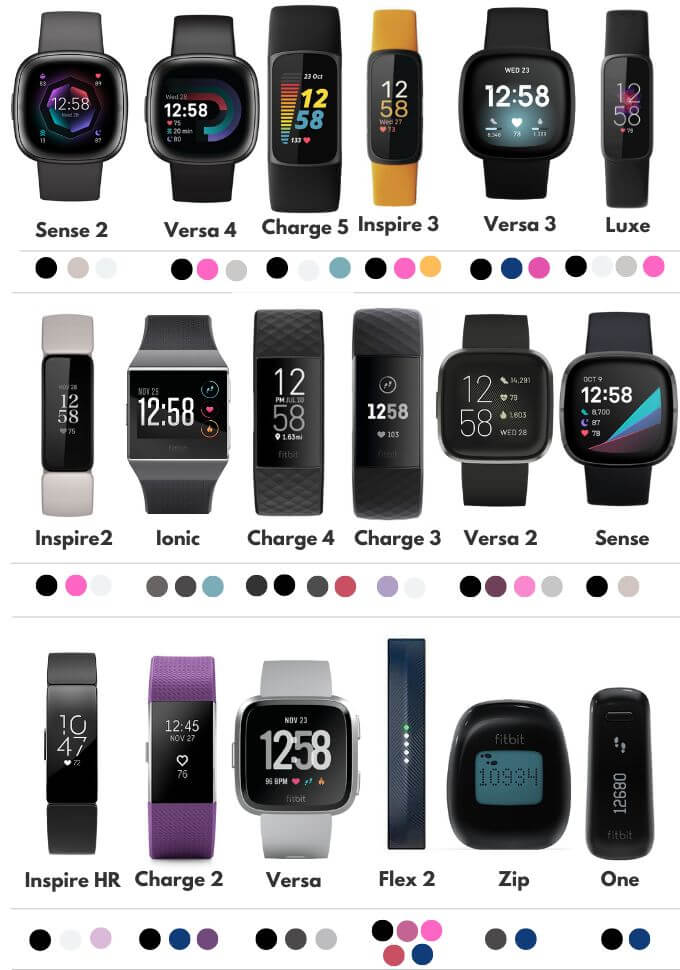
The Fitbit Surge is available in three colors: Black, Blue, and Tangerine. But it’s no longer sold on the Fitbit store, only on Amazon and other online sellers.
Best Fitbit for Men

We have a full review of the different Fitbits for men depending on Smart features, best for running, for sport, the most affordable, and more. So if you would like to check the full review click the link below:
The conversation around men’s fitness trackers tends to focus on ruggedness and advanced metrics, but my research reveals more diverse priorities. Sure, some guys want every possible stat, but others just want something that doesn’t look ridiculous with a suit or annoy them during weightlifting.
The Charge 6 emerges as the clear winner for most men. It strikes that perfect balance between functionality and discretion that guys seem to prefer. The darker colorways (black, graphite) disappear under shirt cuffs during meetings. The button interface works reliably with sweaty or calloused hands where touchscreens fail. Built-in GPS satisfies the data nerds without requiring the bulk of a full smartwatch.
Men who lift weights specifically praise the Charge 6’s form factor. Unlike bulkier smartwatches that interfere with wrist position during deadlifts or catch on barbells during cleans, the Charge 6’s slim profile stays out of the way. The automatic exercise recognition accurately identifies weight training sessions, though you’ll still want to log specific exercises manually for accurate tracking.
The Versa 4 appeals to tech-savvy men who want smartwatch features without abandoning Android for an Apple Watch. The ability to control Spotify, respond to texts with voice, and check weather forecasts adds genuine convenience. The larger screen also benefits men with bigger fingers who struggle with the Charge 6’s smaller touch targets.
Surprisingly, many men gravitate toward the Inspire 3 specifically because it’s unobtrusive. Guys in physical jobs like construction or mechanics appreciate that it doesn’t catch on equipment or get damaged easily. The ten-day battery life means less maintenance fussing, which resonates with men who want to set-and-forget their tech.
The Sense 2 attracts health-focused men, particularly those over forty dealing with stress, blood pressure concerns, or sleep issues. The ECG feature provides peace of mind for guys with family histories of heart problems. Several users mentioned their wives encouraged the purchase after health scares, and the continuous monitoring helps both partners sleep better.
Best Fitbit for Women
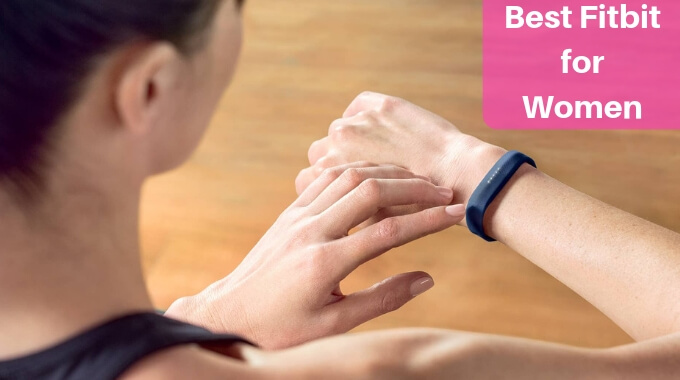
We also have a full review about which Fitbit is the Best for Women, but at the same time, we choose our top picks.
You can check the full review on the link below:
Let me address something that irritates me about most “fitness trackers for women” guides – they focus entirely on pink color options and smaller bands. After interviewing dozens of female Fitbit users, from powerlifters to busy moms to executives, I’ve learned that women’s tracker needs are far more nuanced and practical.
The Inspire 3 dominates among women who prioritize discretion and comfort. Its slim profile doesn’t clash with bracelets or catch on sleeves, problems that sound minor until you’re constantly adjusting your tracker during meetings. The lightweight design also matters during sleep – several women mentioned that bulkier trackers disturbed their partners when cuddling. These aren’t things marketing materials mention, but they’re deal-breakers in real life.
For active women, the Charge 6 hits different. Female runners particularly appreciate the built-in GPS since women’s running clothes rarely have pockets for phones. The safety aspect shouldn’t be overlooked either – being able to track your location without carrying a phone provides peace of mind during early morning or evening runs. The period tracking integration with temperature monitoring has also proven surprisingly accurate for cycle prediction.
The Versa 4 appeals to women wanting style flexibility. With dozens of band options from metal mesh to leather to patterned silicone, you can match any outfit. One user showed me her collection of seven bands for different occasions – workout, office, date night, and so on. The square face reads more like jewelry than tech, especially with an analog clock face displayed.
The Sense 2 attracts health-conscious women, particularly those managing conditions like PCOS or thyroid issues where temperature tracking provides valuable insights. The stress monitoring features resonate with working mothers juggling multiple responsibilities. Several users specifically mentioned how the breathing reminders helped during particularly chaotic days.
Size matters, but not how you’d think. Women with smaller wrists (under 5.5 inches) find even the “small” bands on the Versa 4 and Sense 2 too loose at their tightest setting. Third-party bands solve this problem cheaply. Meanwhile, women with larger wrists appreciate that Fitbit doesn’t assume all women have tiny wrists – the large bands fit comfortably without looking masculine.
What Size Fitbit Should Women Get?
Fitbits come in three standard sizes small, large, and X Large. It’s kind of weird that there’s not a medium or regular size. Fitbit breaks down wrist sizes based on their circumferences (the distance around the outside of your wrist) and ties those with the different product sizes. This makes it easy to buy a Fitbit and know that it will fit your wrist properly, even if you can’t try it on.
WRIST SIZES
Small 5.5″–6.7″ 140 mm–170 mm
Large 6.7″–8.1″ 170 mm–206 mm
X Large 8.1″–9.3″ 206 mm–236 mm
Check here where you can find a band to print and use on your wrist to know the perfect size for your wrist.
What is a Fitbit?
A Fitbit is not just a fitness tracker or a smartwatch is much more than that. You can think that there’s a lot of brands and models around so what makes a difference between Fitbit and the competition?.
The reason to buy a Fitbit is not for the gadget. It is really for the software. The Fitbit app for Android and iOS has become the simplest to use. It has the biggest social base, so you’re able to compete with family and friends, and syncs with a wide range of other services. The app also supports numerous trackers and will automatically identify whenever you change from one device to a different one.
The best thing is that you are able to test-drive the Fitbit app without the need of buying any new hardware. The free app can be downloaded on your iPhone or Android phone and can track steps, distance as well calories burned.
If you want to go ahead and take the Fitbit jump, there is only one problem: deciding on one of the 8 versions that the company offers (which includes some which are years old). It can be confusing at the beginning, but we have created this convenient cheat sheet to help you.
Fitbit Smartwatches vs Fitness Trackers
So you hear a lot about the different Fitbit models but which ones are smart and what is the difference with the fitness trackers?
So to play it simply the main differences are that the smartwatches can perform smart functions such as NFC payment ( you can pay right from your watch) as well advanced health tracking functions such as female health tracking.
Smartwatches can be submerged underwater and track your swimming laps, there are a few apps that are only available for Smartwatches.
But the Fitness trackers are not behind, don’t you think that simply because the smartwatches can track high-end exercises the Fitness trackers can’t.
One of the most advanced fitness trackers on today’s market is the Fitbit Charge 5, which comes with all the features that made the Charge 4 the best seller in Fitbit history but it also adds cool functionalities such as the ability to choose from 15+ exercise modes like run, bike, swim, yoga just to name a few, as well it can track your Deep and REM sleep stages and see activity trends, health insights, and personalized guidance.

Fitbit Premium: The Hidden Cost Nobody Talks About
Here’s something Fitbit doesn’t advertise prominently – many of the most useful features require a Premium subscription at $10 monthly or $80 annually. After the free six-month trial included with most devices, you’ll face a decision that significantly impacts your tracker’s value proposition.
Let’s be brutally honest about what you lose without Premium. Basic tracking remains fully functional – steps, heart rate, sleep stages, and exercise logging work fine. You can still participate in challenges and sync with third-party apps. For many users, this is completely sufficient. If you just want motivation to move more and basic health metrics, save your money.
But Premium unlocks genuinely valuable features that transform your Fitbit from a tracker into a coach. The Daily Readiness Score alone might justify the subscription for serious athletes. It combines sleep quality, heart rate variability, and recent activity to generate a recovery score. On days it suggests rest, I’ve learned to listen – pushing through always leads to subpar performance or minor injuries.
The guided programs provide structure that self-directed fitness often lacks. These aren’t generic YouTube workouts – they adapt based on your fitness level and progress. The running programs particularly impress, gradually building endurance while preventing overtraining. Several couch-to-5K graduates credit these programs for their success.
Sleep insights go way beyond basic tracking. Premium analyzes patterns to identify factors affecting your rest. It discovered my afternoon coffee was disrupting my sleep far more than I realized. The monthly sleep reports compile trends that revealed seasonal patterns I never noticed. Understanding that I naturally need more sleep in winter helped me adjust expectations and schedules accordingly.
Wellness reports compile your health data into physician-friendly formats. Several users mentioned these reports helped doctors identify issues faster. One woman’s report showed heart rate irregularities that led to discovering a thyroid condition. While not diagnostic tools, these reports facilitate better healthcare conversations.
The mindfulness sessions surprised me. I expected generic meditation fluff but found targeted sessions for specific situations – pre-meeting anxiety, post-workout recovery, bedtime racing thoughts. The variety keeps things interesting, and the session lengths (2-20 minutes) fit into realistic schedules.
Advanced metrics like breathing rate trends and temperature variations are Premium-exclusive. These seem niche until you need them. Temperature tracking helped several women optimize fertility planning. Breathing rate changes indicated respiratory infections before symptoms appeared for multiple users.
The Fitbit App: Your Data Command Center
The Fitbit app deserves its own discussion because it’s arguably more important than the hardware. Even the best tracker becomes useless if the app sucks, and thankfully, Fitbit’s doesn’t. After years of refinement, it’s become the gold standard for fitness app design.
The home dashboard customization lets you prioritize what matters. Hate step counting? Hide it. Obsessed with sleep scores? Make it prominent. This flexibility means the app grows with your changing health priorities. My dashboard has evolved from step-focused to sleep and recovery-oriented as my fitness goals shifted.
Social features add surprising motivation. The challenges aren’t just “who walks most” anymore. Weekend Warriors rewards weekend activity, encouraging work-life balance. Daily Showdown creates tournament brackets for competitive types. The ability to create custom challenges with specific friends keeps things interesting. Trash-talking in challenge comments has motivated me through many lazy Sundays.
Data visualization strikes the perfect balance between detailed and accessible. Graphs clearly show trends without overwhelming non-technical users. The ability to zoom from daily to yearly views reveals patterns invisible at smaller scales. Discovering that my resting heart rate drops every summer when I cycle more encouraged maintaining year-round cardio.
Food logging integration with MyFitnessPal eliminates double-entry hassles. Barcode scanning makes tracking packaged foods effortless. The database includes most restaurant chains, though portions require estimation. Water tracking reminders actually work – my hydration improved significantly after enabling them.
The app’s intelligence continues improving. It notices patterns and offers insights like “You sleep better on days you exercise” or “Your stress levels are higher on Mondays.” These seem obvious in retrospect but having data-backed confirmation motivates behavior change.
Syncing reliability has improved dramatically. Early Fitbits required manual syncing and frequently failed. Current models sync automatically whenever your phone is nearby. The only persistent issue involves Android battery optimization occasionally killing background syncing, but this is easily fixed in settings.
Making Sense of Exercise and Sports Tracking
Exercise tracking capabilities vary significantly between models, and understanding these differences prevents disappointment. Each device targets different activity levels and types, from casual walking to serious athletic training.
The Inspire 3’s twenty exercise modes cover most common activities. Running, cycling, swimming, yoga, and weight training are accurately tracked. The automatic exercise recognition kicks in after fifteen minutes of continuous activity, though it sometimes misidentifies activities. Elliptical training often registers as running, for instance. Manual logging takes seconds and ensures accurate categorization.
The Charge 6’s forty exercise modes include niche activities like martial arts, pilates, and bootcamp. More importantly, it provides real-time stats during workouts. Seeing your heart rate zone in real-time enables precise intensity management. The built-in GPS accurately tracks outdoor routes, and the pace alerts keep you on target during training runs.
Both Versa 4 and Sense 2 add on-screen animated workouts. These aren’t just exercise descriptions – they’re full video demonstrations showing proper form. The included workouts range from five-minute stretching routines to forty-five-minute HIIT sessions. New workouts appear regularly, preventing staleness. The audio coaching through connected headphones genuinely feels like having a personal trainer.
Swimming tracking deserves special mention. All current models are swim-proof, but tracking quality varies. The Inspire 3 counts laps reasonably well in pools but struggles with open water. The Charge 6 adds stroke detection, differentiating between freestyle, backstroke, breaststroke, and butterfly. The smartwatches display real-time metrics underwater, though reading them mid-stroke proves challenging.
Strength training remains Fitbit’s weakness compared to Garmin or dedicated gym trackers. While you can log sets, reps, and weights manually, there’s no automatic rep counting or weight detection. The heart rate monitoring during strength training helps gauge intensity, but serious lifters will want additional tools.
Multi-sport tracking on the Charge 6 and smartwatches enables triathlon training. Switching between activities maintains continuous tracking without losing data. The transition times are included, important for race preparation. Several triathletes mentioned this feature alone justified upgrading from simpler models.
Advanced Health Monitoring Features That Actually Matter
Beyond basic fitness tracking, current Fitbits offer legitimate health monitoring capabilities that sometimes reveal serious conditions. Understanding what these features can and cannot do helps set appropriate expectations.
ECG functionality on the Charge 6 and Sense 2 detects atrial fibrillation, an irregular heart rhythm affecting millions. The process takes thirty seconds of holding still, generating a report shareable with physicians. Multiple users report this feature detected previously unknown AFib, prompting medical intervention. However, it’s not continuous monitoring – you must manually initiate each reading.
SpO2 monitoring tracks blood oxygen levels during sleep. While most healthy individuals maintain 95-100% saturation, drops might indicate sleep apnea or other breathing issues. The data helped several users get sleep studies that confirmed apnea diagnoses. Continuous monitoring drains batteries faster, so most users enable it periodically rather than nightly.
Skin temperature variation tracking on the Sense 2 provides surprisingly useful insights. Deviations from your baseline often precede illness symptoms. Women using this for fertility tracking report accuracy comparable to dedicated basal thermometers. The key is establishing a baseline over several weeks before trusting the variations.
Stress notifications based on heart rate variability and electrodermal activity actually work. They’ve caught stress I didn’t consciously recognize during focused work. The prompted breathing exercises might seem annoying initially, but completing them genuinely helps. Several users credit these interventions with improving their stress management.
High and low heart rate notifications can be literal lifesavers. Set appropriate thresholds based on your normal ranges. One user’s high heart rate alert during rest led to discovering a pulmonary embolism. Another’s low heart rate notification revealed medication side effects requiring dosage adjustment.
The Daily Readiness Score (Premium only) combines multiple metrics to assess recovery. It’s particularly valuable for athletes avoiding overtraining. When it suggests rest, listening usually prevents minor injuries that would force longer breaks. The score improves with consistent wear as algorithms learn your patterns.
Battery Life Reality Check: What to Actually Expect
Manufacturers’ battery claims assume optimal conditions that rarely match reality. After extensive real-world testing, here’s what different usage patterns actually deliver.
The Inspire 3’s ten-day claim holds up remarkably well. With normal use – continuous heart rate monitoring, sleep tracking, occasional workout tracking, and moderate notifications – I consistently get eight to nine days. Enable always-on display and expect three to four days. Heavy notification users might see five to six days. Still impressive compared to most competitors.
The Charge 6 delivers five to seven days depending on GPS usage. An hour of GPS tracking costs roughly a day of battery life. Daily runners should expect to charge twice weekly. The rapid charging partially compensates – fifteen minutes provides enough power for a full day. I keep a charger at work for quick top-ups.
The Versa 4 and Sense 2 both manage four to six days with typical use. Always-on display drops this to two to three days. Heavy app usage, music control, and voice assistant queries drain batteries faster. The key is finding your personal balance between features and charging frequency.
Charging habits matter more than maximum battery life. The Inspire 3’s long battery means charging becomes forgettable – several users mentioned dead batteries ruining tracking streaks. Shorter battery life devices naturally develop charging routines. Most Charge 6 users charge during morning showers, missing minimal tracking time.
Battery degradation occurs but slower than smartphones. After two years, expect roughly 80% of original capacity. My three-year-old Charge 4 still manages four days versus the original seven. Replacement batteries aren’t user-serviceable, so factor this into long-term cost calculations.
Environmental factors affect battery life significantly. Cold weather reduces battery capacity by up to 30%. Screen brightness in sunny conditions drains power faster. Bluetooth connection quality impacts power draw – poor connections cause constant searching that kills batteries.
Sleep Tracking Deep Dive: What It Really Tells You
Sleep tracking has become Fitbit’s standout feature, providing insights that genuinely improve rest quality. Understanding what the data means and how to use it makes the difference between pretty graphs and actual sleep improvement.
Sleep stages (Light, Deep, REM) are surprisingly accurate compared to medical sleep studies. While not diagnostic-quality, the trends over time reveal patterns. Consistently low deep sleep might indicate stress or recovery issues. REM sleep deficiencies often correlate with mood and cognitive problems.
The Sleep Score simplifies complex data into a single metric. Scores above 80 indicate good rest, while below 70 suggests problems. The breakdown shows which factors hurt your score – maybe duration is fine but restlessness is high. This targeted feedback enables specific improvements rather than vague “sleep better” advice.
Sleep consistency metrics revealed my biggest issue wasn’t duration but timing irregularity. Going to bed within a thirty-minute window dramatically improved my sleep quality within weeks. The app’s bedtime reminders help maintain consistency, especially on weekends when routines typically break.
Smart Wake (Charge 6 and up) uses sleep cycles to wake you during lighter sleep within a thirty-minute window. The difference is remarkable – waking from light sleep feels natural while deep sleep interruption causes grogginess lasting hours. Several users report this feature alone justifies upgrading from basic trackers.
Environmental factors tracked by the Sense 2 (noise and temperature) provide context for poor sleep. Discovering that room temperature variations correlated with restlessness led to thermostat adjustments that improved sleep quality. The snoring detection helped one user’s partner get diagnosed with sleep apnea.
Comparing Fitbit to the Competition in 2025
Understanding how Fitbit stacks up against alternatives helps confirm your choice or identify better options for specific needs. Each competitor excels in different areas, and honest comparison prevents buyer’s remorse.
Garmin dominates serious endurance athletics. Their GPS accuracy and advanced training metrics exceed Fitbit’s capabilities. Features like training load, recovery time, and performance condition provide insights Fitbit lacks. However, the interface complexity overwhelms casual users, and the app lacks Fitbit’s social features and simplicity. Prices run significantly higher for comparable features.
Apple Watch Series 9 offers unmatched smartwatch functionality for iPhone users. The app ecosystem dwarfs Fitbit’s limited selection. Health features like fall detection and crash detection add safety. However, daily charging remains mandatory, and the fitness tracking, while good, lacks Fitbit’s specialized focus. The price premium only makes sense if you’ll use the smart features.
Samsung Galaxy Watch 6 provides similar trade-offs for Android users. Beautiful displays and rotating bezels create premium experiences. Deep Android integration enables features Fitbit can’t match. But again, battery life maxes out at two days, and fitness tracking feels secondary to smartwatch features.
Whoop takes a completely different approach with subscription-based, screenless tracking focused on recovery and strain. Serious athletes love the detailed recovery metrics and training recommendations. The lack of screen eliminates distractions. However, the $30 monthly subscription adds up quickly, and the lack of basic features like step counting frustrates many users.
Oura Ring offers discrete tracking in ring form factor. Sleep tracking rivals Fitbit’s accuracy, and the form factor suits those who hate wrist devices. Temperature tracking excels for fertility planning. However, activity tracking is basic, no real-time display means phone dependency, and the $300+ price plus optional subscription seems steep.
Amazon’s Halo devices failed and were discontinued, validating Fitbit’s ecosystem approach. Cheap trackers from Xiaomi and Amazfit provide basic functionality at rock-bottom prices but lack ecosystem polish and long-term support.
Privacy and Data Security: The Uncomfortable Truth
Google’s acquisition raised legitimate privacy concerns that deserve honest discussion. Your health data is deeply personal, and understanding how it’s used helps make informed decisions.
Fitbit data remains relatively isolated from other Google services for now. Health data doesn’t inform ad targeting, and you can use Fitbit without a Google account (though this may change). However, Google’s history suggests eventual deeper integration is likely.
Data deletion options exist but aren’t straightforward. You can delete your account entirely, removing all historical data. Selective deletion of specific activities or days is also possible but tedious. The app doesn’t make these options obvious, requiring digging through settings menus.
Third-party app permissions deserve scrutiny. That fitness app requesting Fitbit access might share your data further. Review permissions regularly and revoke access for unused apps. The convenience of integration must be balanced against privacy preferences.
Location tracking through GPS workouts creates detailed movement patterns. While useful for route mapping, this data reveals home addresses, workplace locations, and routine patterns. Consider privacy implications before sharing workout routes publicly through Strava or similar platforms.
Health report sharing with healthcare providers is optional but encouraged by Fitbit. While potentially beneficial for medical care, understand that this data enters your medical record, potentially affecting insurance rates or employment in edge cases.
European users benefit from GDPR protections providing more control over data usage. American users have fewer legal protections, making personal vigilance more important. Reading privacy policies is tedious but important for understanding your rights.
Final Buying Advice: Making the Right Choice
After thousands of words of analysis, let me distill everything into actionable buying advice. The perfect Fitbit depends on your specific situation, and these recommendations come from real-world experience.
For first-time fitness tracker buyers, start with the Inspire 3. Its simplicity prevents overwhelm while providing comprehensive basic tracking. The low price reduces commitment anxiety, and the comfortable design ensures consistent wear. If you outgrow it, upgrading later is easy with all your data preserved.
Runners and outdoor enthusiasts should go straight to the Charge 6. Built-in GPS is non-negotiable for serious training, and the form factor balances functionality with practicality. The price premium over the Inspire 3 is justified by GPS alone, and additional features like ECG provide bonus value.
Smart feature lovers face a tougher choice. The Versa 4 provides good smartwatch functionality at reasonable prices with excellent battery life. But if you’re truly prioritizing smart features, consider the Google Pixel Watch 2 despite battery life compromises. The fuller smartwatch experience might be worth daily charging.
Health-focused users should invest in the Sense 2. The additional sensors provide insights unavailable elsewhere, potentially catching issues early. The stress tracking and temperature monitoring alone justify the premium for many users. Consider it health insurance rather than a fitness tracker.
Budget-conscious buyers should watch for sales rather than settling for lesser models. Black Friday regularly sees 30-40% discounts. Previous generation models (Charge 5, Versa 3) offer 90% of current features at significant discounts. Refurbished units from Fitbit directly include warranties and work perfectly.
Consider Premium subscription costs in your budget. The free trial lets you evaluate value, but factor the ongoing cost into purchase decisions. Some users find Premium essential, others never subscribe after trials expire. Try before committing to annual plans.
Don’t overlook band costs. While devices include basic bands, most users buy alternatives for comfort or style. Budget $20-50 for additional bands, especially if you’ll wear your tracker constantly.
The most important advice? Buy from retailers with good return policies. Despite research, you won’t know if a tracker suits you until wearing it for several days. Amazon, Best Buy, and Fitbit directly offer reasonable return windows. Use them if needed.
Remember that consistency matters more than capability. The fanciest tracker becomes worthless unworn. Choose the model you’ll actually use daily, even if it means sacrificing advanced features for comfort or simplicity. Your health journey depends on consistent data, not perfect data.
This comprehensive guide should provide everything needed for an informed Fitbit purchase. The perfect model exists for your specific needs – now you have the knowledge to identify it confidently and avoid the costly mistakes others make. Your fitness journey starts with the right tool, and that tool is waiting for you.
As we said at the beginning the Cheapest Fitbit is the regular Inspire but it lacks some features such as an altimeter to measure floors climbed, multi-sport functions, heart rate, and GPS tracking. So for a few extra bucks, you can get the Inspire HR that includes swim-tracking, heart-rate, Cardio Fitness, and sleep analysis.
One thing is for sure every person who has ever used a Fitbit says the same thing: there’s no better exercise tracker available on the market.
Fitbit simply cannot be beaten in price, packaging, or use. Regardless of whether you are new to the health club scene or a veteran, you are going to love Fitbit and all it has to offer.
You can always come back and check this Fitbit Review and Fitbit comparison table whenever you need to get a Fitbit for yourself or your loved ones.
Related:
References
